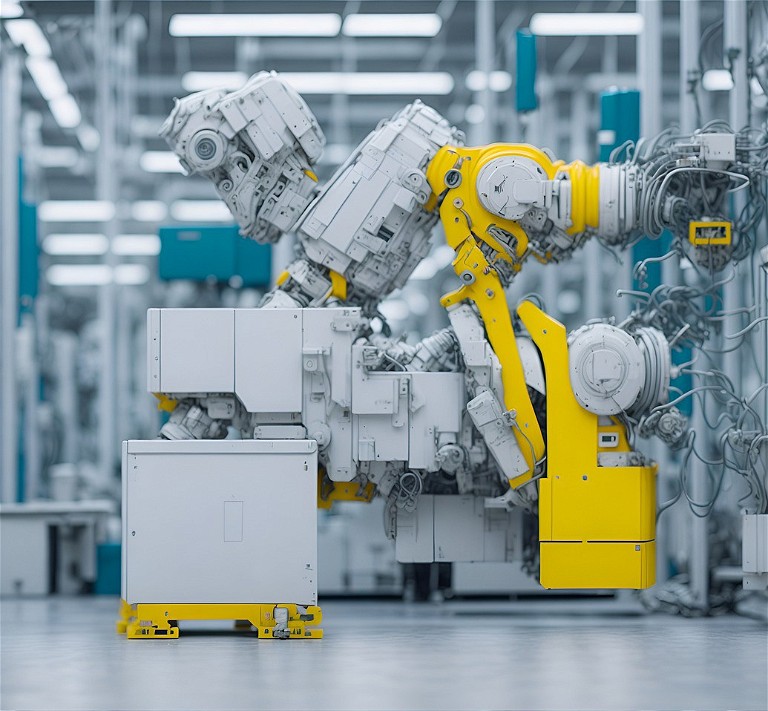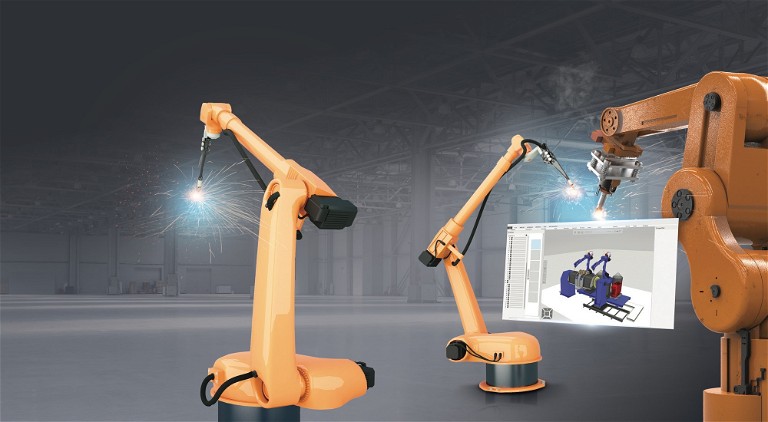Robotics
Why manufacturers can rely on robots to bridge efficiency gaps and streamline processes
Robots are revolutionising manufacturing, but manual programming hampers their potential. Robot offline programming offers a digital solution, reducing human work hours by up to 80% and ensuring swift task readiness
Mikko Urho at Visual Components
Robots are more often assuming the once human-dominated tasks that are typical on the factory floor. As this trend grows, a staggering 518, 000 industrial robot installations are expected globally this year. As Industry 4.0 evolves into 5.0, manufacturers are exploring ways to achieve new efficiencies while bringing their employees into the centre of the production process and robots are increasingly at the core of digital transformation.
However, these automated machines do require programming and maintenance to get to work and accurately complete their duties. As is often the case for manufacturers, time-consuming manual programming is required for robots to complete welding, cutting, painting or other processes. It’s this type of programming that is hampering the ability to fully utilise their many capabilities, which would otherwise help to bridge the efficiency gaps and streamline processes in the factory environment.
The importance of not being idle
Robots hold the key to quicker, highly accurate and infinitely repeatable processes. Unlike human workers, they are not susceptible to errors and don’t tire throughout the day. The automotive sector is an industry that has recognised the benefits of robotic technology. Many utilise various applications to assemble a car, which can be made up of as many as 30, 000 different components. While there may be fewer components to a pharmaceutical product, items can still be assembled quicker and with greater accuracy with robots, critical for highly regulated medical products. Others have noted the flexibility brought about by collaborative robots, or ‘cobots‘. These deployments are extremely flexible in their operation. Employees can set them up in areas with limited floor space and be applied to various tasks due to being lightweight in nature. Being smaller and lighter, manufacturers also save money as they are cheaper to deploy.
But to ensure that each and every robot and cobot can perform their specific task, they need to be programmed correctly to do their job quickly and accurately so a product can move down the production line. Say that the robot needs to move a welding torch in a circular 3D arc around a metal workpiece. It might seem like a simple process, but manually programming it can be a time-consuming project that then needs to be replicated across other robots. In fact, the programming process is usually not just a matter of hours or days. Some robots can sit idle for weeks or even months in the worst-case scenarios before they are fully utilised.
And for every extra day a robot remains unused due to a lengthy manual programming process, the return-on-investment figure on an expensive outlay worsens and only increases the time before production lines get going and items are sent down the supply chain. With a large proportion of factory floor tasks falling under the description of a repetitive action, there are numerous tasks that robotic deployments are not yet taking responsibility for. To add complexity to the challenge, manufacturers have a tendency to deploy multiple robot brands, further complicating the programming procedure due to the differences in how they operate.

Creeping costs and the persistent skills shortage
It’s not only important to get a robot up and running quickly to improve utilisation rates and return on investment, but to eradicate any errors and put human needs at the forefront during the process. Any oversights made in the manual programming process can raise the risk of costly mistakes and require staff to go back to the drawing board. Even something as simple as the robot not being able to reach a vital component can be catastrophic financially. Incorrectly manufactured products can lead to significant waste in terms of both materials and costs. Therefore, failing to use robots to their full capability is not a financial risk they can afford to take.
It’s an outgoing on the balance sheet that manufacturers understandably want to avoid during a cost-of-living crisis and persistently high inflation raising the prices of goods and services from suppliers. Cost pressures are likely to have ramifications elsewhere. They can affect the confidence among manufacturers that they will play a key role in the global effort for net zero carbon emissions as budgets have to be reallocated to urgent fixes.
But manual programming also brings the issue of staff safety. The biggest and heaviest equipment may require engineers to move behind safety lines or climb ladders to high-up positions to complete a manual programming process. Not only is this dangerous, but there may not be sufficiently trained professionals at the business to complete that task due to skills shortages in the sector. The skills shortfall in the manufacturing sector is well documented. A WorldSkills UK report earlier in 2023 laid bare the extent of the challenge in attracting new workers to the sector, with 83% of young people facing barriers. To add to the issue, 48% have never received any information about why or how they should pursue it as a career. It’s perhaps therefore unsurprising that as many as 60% of young people (16-24) wouldn’t consider a career in manufacturing. As older skilled professionals retire, there’s an insufficient pipeline of young talent coming in to replace those who leave.
It's another rallying call to manufacturers to get their robotic deployments in order. If the technology is up and running quickly, safely and accurately, staff can save time on manual work and focus on more important priorities. This can help to raise morale and job satisfaction. Supporting solutions need to be fully integrated to allow workers to maximise the efficiency offered by robotic deployments and develop their skills on the factory floor.
Automation in abundance
Rather than placing the emphasis on factory staff to test and train robotic applications manually on the physical floor, robot offline programming (OLP) moves the process into the digital sphere. OLP works by creating a highly accurate digital model of the robot and its work cell, with its movements and workflows then fully replicated via simulation. Automated programming with OLP brings a number of benefits to factory operations and the people working at the business. Programming is completed concurrently alongside the deployment of the robot, as opposed to sequentially, which means that production doesn’t have to come to a halt. This means that significantly less time is spent on preparation before a new innovative product can be put into production. There are also opportunities to validate an item design, including workpiece design and fixtures supporting or holding the workpiece, before putting it into production. It’s this virtual sandbox that gives staff unlimited opportunities to refine a robotic process to be highly accurate. Any potential errors, such as a robot not being able to reach a component, can be fully eradicated.
OLP can fully maximise the potential of robots and quickly create efficiencies across applications including cloning, management of multipass welds, automatic external axes optimisation, weld databases (WPS), vision system integration and programme templates. And the numbers speak for themselves: programming human work hours can be reduced by as much as 80%, with a robot fully ready to complete its task in days. Return on investment is drastically improved and manufacturers can ramp up output of the final product to bring revenue in quicker.
With all the process and programming expertise stored in the software, manufacturers can rest easier in the event of knowledgeable staff leaving the business. Engineers can access upskilling opportunities by deploying different robot brands with varying capabilities to complex processes and all from a position of safety. There’s even an opportunity to work in a more environmentally friendly way. With higher accuracy and consistency, organisations can eliminate the potential negative consequences of manual programming, such as lost parts and wasted robot movements. Automated programming can be completed remotely, allowing staff to undertake the process from home and avoid carbon emissions produced from travelling to the factory.

OLP is vital to optimise robotic deployments, and the technology can also serve as one solution within a wider portfolio of technologies to help further digital transformation strategies. To create a fully automated factory environment, simulation software can help employees with layout design, feasibility and validation of control logics and processes, helping to increase efficiency in all aspects of manufacturing.
Unleashing robots on the factory floor
The future of manufacturing is inextricably linked with the effective deployment and utilisation of robots. While the industrial sector is poised to witness a significant increase in robot installations, the challenges of manual programming and maintenance remain a major hurdle. These barriers not only delay production, but also incur additional costs and exacerbate the skills shortage in the sector.
However, the adoption of OLP and simulation software offers a promising solution. By transitioning to offline digital programming, manufacturers can significantly reduce programming time, eliminate errors and improve return on investment. In addition, the shift towards automated programming and simulation will not only optimise production processes, but also offer environmental benefits and upskilling opportunities for engineers.
The industry continues to navigate through challenges such as the cost-of-living crisis, the need for environmental sustainability and the skills shortfall. These technological advancements will be crucial in shaping a more efficient, safe and innovative manufacturing landscape, which is vital in the pharmaceutical sector.

Mikko Urho has an extensive career with Visual Components, dating back to the year 2000 as a summer trainee. He became CEO of the company in March 2021. His vast experience includes direct sales, building a world-wide partner network and managing reseller channels. He is well known and respected by many of Visual Components‘ partners and customers around the globe.